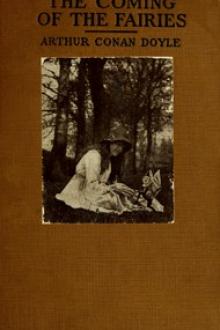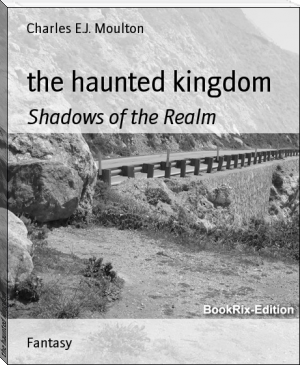The Coming of the Fairies, Arthur Conan Doyle [motivational novels .TXT] 📗

- Author: Arthur Conan Doyle
- Performer: -
Book online «The Coming of the Fairies, Arthur Conan Doyle [motivational novels .TXT] 📗». Author Arthur Conan Doyle
"Plant Consciousness.—The relation of the nature spirit to the consciousness functioning through the vegetable kingdom generally is an interesting study too, for the twain appear quite separate. This might perhaps be likened to the rôle respectively of crew and passenger in a ship. The slumbering, or at best slowly awakening, consciousness of the plant, makes of it little more than an idle traveller, whereas the nature spirits, alert and active, attend to the upkeep and navigation of the craft, and the voyage through the kingdom means a growth and development for both.
"The Future.—What might follow an intelligent understanding of the 'little people,' and the establishment of mutual good feeling, opens up a prospect alluring in the extreme. It would be for us a working in the light instead of in darkness. A foretaste of such co-operation may be gathered by noting the effect of a devoted lover of flowers on his or her charges. The nature spirit responds to emotion and appears keenly appreciative of kindly attention and affection. Whether this applies with any force to any but the varieties concerned with flowers and fruits I cannot say, but it certainly does to them, and the intelligent direction of effort in place of empirical incident tempts one's speculation to run riot as to future possibilities.
"The awakened self-consciousness of the human kingdom, with a vigorous mentality linked to kindly emotion and physical action, may enable an ages-old debt to be adjusted. We have served the nature-spirit line of evolution consciously not at all, but by understanding the situation we can co-operate together intelligently and helpfully, and the service of both to mutual advantage can take the place of blind experiment and groping self-interest."—E. L. G.
In the literature of Theosophy, I know no one who treats the elemental forces of nature more fully than Bishop Leadbeater, whom I met in my Australian travels, and who impressed me by his venerable appearance, his ascetic habits, and his claims to a remarkable clairvoyancy which has, as he alleges, opened up many of the Arcana. In his book The Hidden Side of Things he talks very fully of the fairies of many lands.
Dealing with the little creatures whom so many of my informants have seen tending flowers, the seer says:
"The little creatures that look after flowers may be divided into two great classes, though of course there are many varieties of each kind. The first class may properly be called elementals, for, beautiful though they are, they are in reality only thought-forms, and therefore they are not really living creatures at all. Perhaps I should rather say that they are only temporary living creatures, for, though they are very active and busy during their little lives, they have no real evolving, reincarnating life in them, and when they have done their work they just go to pieces and dissolve into the surrounding atmosphere, precisely as our own thought-forms do. They are the thought-forms of the Great Beings, or angels, who are in charge of the evolution of the vegetable kingdom.
"When one of these Great Ones has a new idea connected with one of the kinds of plants or flowers which are under his charge, he often creates a thought-form for the special purpose of carrying out that idea. It usually takes the form either of an etheric model of the flower itself or of a little creature which hangs round the plant or the flower all through the time that the buds are forming, and gradually builds them into the shape and colour of which the angel has thought. But as soon as the plant has fully grown, or the flower has opened, its work is over and its power is exhausted, and, as I have said, it just simply dissolves, because the will to do that piece of work was the only soul that it had.
"But there is quite another kind of little creature which is very frequently seen playing about with flowers, and this time it is a real nature spirit. There are many varieties of these also. One of the commonest forms is, as I have said, something very much like a humming-bird, and it may often be seen buzzing round the flowers much in the same way as a humming-bird or a bee does. These beautiful little creatures will never become human, because they are not in the same line of evolution as we are. The life which is now animating them has come up through grasses and cereals, such as wheat and oats, when it was in the vegetable kingdom, afterwards through ants and bees when it was in the animal kingdom. Now it has reached the level of these tiny nature spirits, and its next stage will be to ensoul some of the beautiful fairies with etheric bodies who live upon the surface of the earth. Later on they will become salamanders, or fire spirits, and later still they will become sylphs, or air spirits, having only astral bodies instead of etheric. Later still they will pass through the different stages of the great kingdom of the angels."
Speaking of the national characteristics of fairies, he says with all the assurance of an actual observer (page 97):
"No contrast could well be more marked than that between the vivacious, rollicking, orange-and-purple or scarlet-and-gold mannikins who dance among the vineyards of Sicily and the almost wistful grey-and-green creatures who move so much more sedately amidst the oaks and furze-covered heaths in Brittany, or the golden-brown 'good people' who haunt the hillsides of Scotland.
"In England the emerald-green kind is probably the commonest, and I have seen it also in the woods in France and Belgium, in far-away Massachusetts, and on the banks of the Niagara River. The vast plains of the Dakotas are inhabited by a black-and-white kind which I have not seen elsewhere, and California rejoices in a lovely white-and-gold species which also appears to be unique.
"In Australia the most frequent type is a very distinctive creature of a wonderful luminous sky-blue colour; but there is a wide diversity between the etheric inhabitants of New South Wales or Victoria and those of tropical Northern Queensland. These latter approximate closely to those of the Dutch Indies. Java seems specially prolific in these graceful creatures, and the kinds most common there are two distinct types, both monochromatic—one indigo blue with faint metallic gleamings, and the other a study in all known shades of yellow—quaint, but wonderfully effective and attractive.
"A striking local variety is gaudily ringed with alternate bars of green and yellow, like a football jersey. This ringed type is possibly a race peculiar to that part of the world, for I saw red and yellow similarly arranged in the Malay Peninsula, and green and white on the other side of the Straits in Sumatra. That huge island also rejoices in the possession of a lovely pale heliotrope tribe which I have seen before only in the hills of Ceylon. Down in New Zealand their speciality is a deep blue shot with silver, while in the South Sea Islands one meets with a silvery-white variety, which coruscates with all the colours of the rainbow, like a figure of mother-of-pearl.
"In India we find all sorts, from the delicate rose-and-pale-green, or pale-blue-and-primrose of the hill-country to the rich medley of gorgeously gleaming colours, almost barbaric in their intensity and profusion, which is characteristic of the plains. In some parts of that marvellous country I have seen the black-and-gold type which is more usually associated with the African desert, and also a species which resembles a statuette made out of a gleaming crimson metal, such as was the orichalcum of the Atlanteans.
"Somewhat akin to this last is a curious variety which looks as though cast out of bronze and burnished; it appears to make its home in the immediate neighbourhood of volcanic disturbances, since the only places in which it has been seen so far are the slopes of Vesuvius and Etna, the interior of Java, the Sandwich Islands, the Yellowstone Park in North America, and a certain part of the North Island of New Zealand. Several indications seem to point to the conclusion that this is a survival of a primitive type, and represents a sort of intermediate stage between the gnome and the fairy.
"In some cases, districts close together are found to be inhabited by quite different classes of nature spirits; for example, as has already been mentioned, the emerald-green elves are common in Belgium, yet a hundred miles away in Holland hardly one of them is to be seen, and their place is taken by a sober-looking dark-purple species."
Very interesting indeed is his account of the Irish fairies. Speaking of a sacred mountain in Ireland, he says:
"A curious fact is that altitude above the sea-level seems to affect their distribution, those who belong to the mountains scarcely ever intermingling with those of the plains. I well remember, when climbing Slieve-na-mon, one of the traditionally sacred hills of Ireland, noticing the very definite lines of demarcation between the different types. The lower slopes, like the surrounding plains, were alive with the intensely active and mischievous little red-and-black race which swarms all over the south and west of Ireland, being especially attracted to the magnetic centres established nearly two thousand years ago by the magic-working priests of the old Milesian race to ensure and perpetuate their domination over the people by keeping them under the influence of the great illusion. After half an hour's climbing, however, not one of these red-and-black gentry was to be seen, but instead the hill-side was populous with the gentler blue-and-brown type which long ago owed special allegiance to the Tuatha-de-Danaan.
"These also had their zone and their well-defined limits, and no nature spirit of either type ever ventured to





Comments (0)